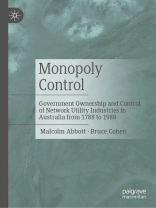This book traces the historical development of the network utilities sector in Australia (communications, rail, gas, electricity, water supply, and sewerage services). It looks across industries, time periods and the state and federal jurisdictions, to identify what motivated the various governments to establish these enterprises and what issues arose. The book is therefore informed by the relationship between politics and society on the one hand and economic history on the other; as well as the efforts of governments in Australia to promote economic growth and the wealth of Australians. The main focus of the book is to identify and analyse the following two main questions: (i) What were the main drivers and motivations for governments establishing government-owned business in the network utilities sector? (ii) To what degree were these government-owned businesses successful at achieving the aims of these governments? In doing so the inherent characteristics of these industries areidentified, in terms of their need for rights of way, network effects, the monopoly characteristics, and the potential for stimulating growth.
Table des matières
Part I: Setting the framework.- Chapter 1: Introduction.- Chapter 2: Australian economic development and network utilities.- Part II: The construction of the new infrastructure: the 19
th century.- Chapter 3: Infrastructure development: industrialisation, institutions, private interests, and public capital investment.- Chapter 4: The colonial post office.- Chapter 5: Local supply networks: water and gas.- Chapter 6: Railways: emergence and development.- Part III: A new nation and its networks: 1901 to 1945.- Chapter 7: Infrastructure provision for a new nation.- Chapter 8: The development of telecommunications.- Chapter 9: Urban amenities: electricity, gas, and tramways.- Chapter 10: The railways: growth and decline.- Part IV: The post-war era: 1945 to 1988.- Chapter 11: The post-war world.- Chapter 12: Telecommunications: extending the network.- Chapter 13: Urban growth and change.- Chapter 14: Transport: a new way forward.- Part V: Conclusion.- Chapter 15: Economic policy, service delivery, and productivity.
A propos de l’auteur
Malcolm Abbott is an economist by profession who specialises in research in energy markets, water supply, transport, and network industries in general. In the past he has worked for the ACCC, KPMG, as a Ministerial Advisor, and as an Associate Professor of Economics at the Swinburne University of Technology in Australia. He holds a Ph.D. from the University of Melbourne.
Bruce Cohen is a private consultant and former barrister who has worked extensively in the energy and water sectors in Australia. He holds a Ph.D. in Public Policy from The Australian National University and has been a member of the board of directors of a number of utility companies, a Commissioner of the Victorian Competition and Efficiency Commission, and a former Chair of Vic Track and the Victorian Commission for Gambling and Liquor Regulation.












